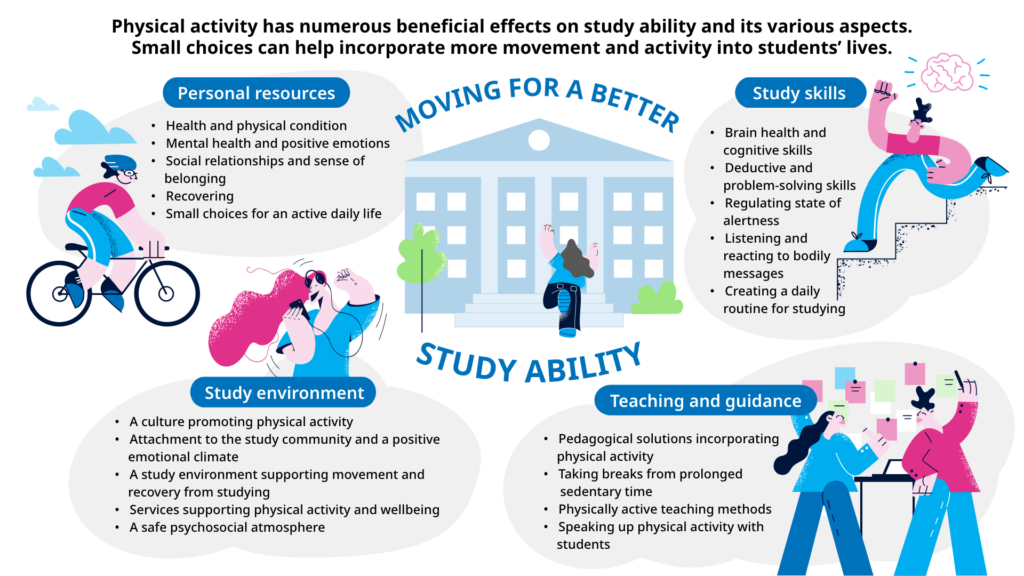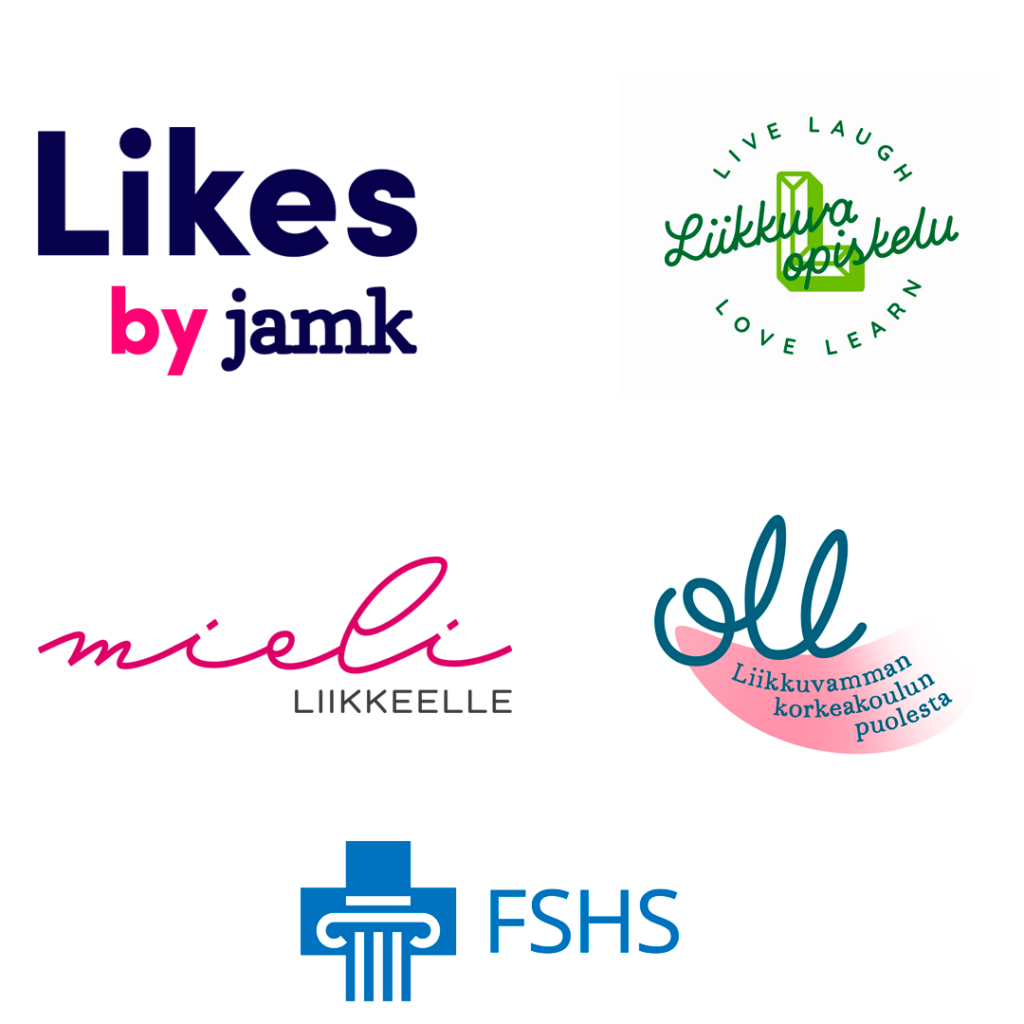Moving for a better study ability
Moving and taking breaks from prolonged sedentary time are ways to support students’ study ability and the wellbeing of study communities. Small choices made by students themselves and measures taken by educational institutions can help incorporate more movement and activity into students’ lives.
The Moving for a better study ability model is based on the model for study ability (Kunttu 2006) updated by the Finnish Student Health Service (FSHS) in 2022. It examines study ability and its various aspects from the point of view of physical activity:
- How can physical activity boost students’ personal resources and study skills?
- How can physical activity be used to promote study environments that support wellbeing?
- How can physical activity be incorporated into teaching and guidance situations with students?
The model below illustrates and explains the importance of measures to support all types of movement in educational institutions. It provides examples of how those working with students, and students themselves, can use physical activity to promote study ability. It can also help to broach the topic and help students to understand the importance of movement and taking breaks from prolonged sedentary time for their own wellbeing.

Content
- Personal resources
- Study skills
- Study environment
- Teaching and guidance
- Members of working group
- References
- The alt text for the picture of the model Moving for a better study ability
Personal resources
Physical activity together with enough sleep and a healthy diet supports wellbeing and personal resources. Physical activity can promote and help treat physical health, fitness and mental health. It has also been shown to be linked to positive emotions, such as happiness, self-appreciation and satisfaction with life. Positive emotions support wellbeing, learning and the motivation to be physically active.
Physical activity can also act as a way to process difficult emotions associated with studying, such as anxiety, nervousness and fear. It reduces symptoms of depression and helps ease anxiety. Physical activity has been shown to be associated with less stress and less student burnout.
Being physically active and move in a group can promote social relationships and a sense of community and belonging. It can also strengthen social interaction skills and boost psychological wellbeing. An atmosphere of safety and confidentiality is important within a group.
The amount of daily physical activity can be increased by making active choices such as taking the stairs or travelling to and from places of study in ways that involve physical activity. These important, health-promoting daily choices can boost energy levels throughout the day. Considering one’s own personal resources is important, as is adjusting all movement and exercise to one’s life situation and overall stress load.
Study skills
Physical activity have been shown to be linked to greater study success. It supports brain health and functions needed for learning, such as attentiveness, memory and executive function. Physical activity is positively associated with deduction and problem-solving skills, allowing for creativity and flexibility in thinking.
Physical activity helps with creating a daily routine and make studying smoother. Breaks are needed during the study day to promote recovery. Even short periods of movement and bodymind exercises can help improve concentration and regulate state of alartness so that they are suitable for learning. Taking breaks means better control of the overall stress load, ensuring that there is enough energy left for enjoyable free-time activities. Recovering during the day also has a positive impact on sleep quality and general energy levels.
Study environment
It’s important that the study environment and its culture support the physical and mental wellbeing of the study community and facilitate social interaction. Study facilities, including furniture, should be accessible and allow students to have freedom of movement and to take active breaks, and for staff to incorporate more activity into lectures.
Providing of physical activity equipment or facilities in the study environment lowers the threshold for exercise and recovery during the study day. A study environment that is accessible to all students and which permits physical activity promotes student wellbeing, as do activities that provide positive experiences for different kinds of learners.
Anyone at an educational institution can bring up the topic of physical activity. It’s important that students and staff are aware of the services that support exercise and wellbeing, such as groups organised by the educational institution, university sports services and services provided by student healthcare, so that students can be referred to them. The study community work done by the Finnish Student Health Service is aimed at strengthening study communities’ ability to promote their members’ health and wellbeing.
Movement within educational institutions – whether during or outside of classes – is a way to promote a positive atmosphere and emotional climate as well as attachment to study communities. Active communication by the institution about the effects of physical activity supports the wellbeing of the entire community.
Teaching and guidance
The culture within educational institutions should be developed so that taking breaks and promoting movement becomes a natural part of teaching and guidance situations. This is important in all study fields, but particularly in those where studies don’t generally include active teaching methods or teaching methods that allow for freedom of body movement.
Lecturers and other staff play an important role in regulating students’ stress load and facilitating breaks from sitting. In both in-person and remote classes students and lecturers can agree to take breaks reserved for physical activity or recovery from studying. Students can also be given guidance on identifying and expressing their need for a break.
To support learning, teaching staff can help maintain students’ alertness at a level suitable for learning by varying teaching methods. Instead of lecturing, lecturers can choose to incorporate approaches such as experiential exercises or active teaching methods.
Members of the working group (click to open)
Liikkuva opiskelu, Jamk University of Applied Sciences, Likes: Anu Kangasniemi, Saara Koskinen & Kirsti Siekkinen
The Finnish Student Sports Federation (OLL): Jussi Ansala & Anni Liina Ikonen
The Finnish Student Health Service (FSHS): Miia Puustinen
References (click to open)
An H.-Y., Chen W., Wang C.-W., Yang H.-F., Huang W.-T. & Fan S.-Y. 2020. The relationships between physical activity and life satisfaction and happiness among young, middle-aged, and older adults. Int J Environ Res Publ Health. 17 (13):4817.
Bailey, A., Hetrick, S., Rosenbaum, S., Purcell, R., & Parker, A. 2018. Treating depression with physical activity in adolescents and young adults: A systematic review and meta-analysis of randomised controlled trials. Psychological Medicine, 48(7), 1068-1083.
Barbosa A., Whiting S., Simmonds P., Scotini Moreno R., Mendes R. & Breda J. 2020. Physical Activity and Academic Achievement: An Umbrella Review. International Journal of Environmental Research and Public Health. 2020; 17(16):5972.
Doré, I., O’Loughlin, J. L., Beauchamp, G., Martineau, M., & Fournier, L. 2016. Volume and social context of physical activity in association with mental health, anxiety and depression among youth. Preventive Medicine, 91, 344–350.
Galper, D. I., Trivedi, M. H., Barlow, C. E., Dunn, A. L., & Kampert, J. B. 2006. Inverse association between physical inactivity and mental health in men and women. Medicine & Science in Sports & Exercise, 38, 173-178.
Gerber, M., Lang, C., Feldmeth, A.K., Elliot, C., Brand, S., Holsboer Trachsler, E. & Pühse, U. 2015. Burnout and Mental Health in Swiss Vocational Students: The Moderating Role of Physical Activity. Journal of Research on Adolescence, 25(1), 63–74.
Dale, P.L., Vanderloo, L., Moore, S. & Faulkner, G. 2019. Physical activity and depression, anxiety, and self-esteem in children and youth: An umbrella systematic review. Mental Health and Physical activity, 16, 66–79.
Dunn, A. L., Trivedi, M. H., & O’Neal, H. A. 2001. Physical activity dose-response effects on outcomes of depression and anxiety. Medicine & Science in Sports & Exercise, 33, 587e597.
Haverkamp B. F., Wiersma R., Vertessen K., van Ewijk H., Oosterlaan J. & Hartman E. 2020. Effects of physical activity interventions on cognitive outcomes and academic performance in adolescents and young adults: A meta-analysis. Journal of Sports Sciences; 38(23): 2637–2660.
Hlas A. C., Neyers K. & Molitor S. Measuring student attention in the second language classroom. Language Teaching Research 2019; 23(1): 107–125.
Holm N., Ikonen J., Siekkinen K., Ansala J. & Parikka S. 2023. Tässä istun enkä muuta voi – korkeakouluopiskelijoiden istuminen ja paikallaanolon paikat koronaepidemian aikana. Tutkimuksesta tiiviisti 12/2023. Terveyden ja hyvinvoinnin laitos, Helsinki.
Kemel, P. N., Porter, J. E., & Coombs, N. 2022. Improving youth physical, mental and social health through physical activity: A Systematic literature review. Health Promotion Journal of Australia: Official Journal of Australian Association of Health Promotion Professionals, 33(3), 590–601.
Korkeakoululiikunnan suositukset 2018 – Korkeakoululiikunnan päivitetyt suositukset & muita korkeakoululiikunnan ajankohtaisia teemoja. Opiskelijoiden Liikuntaliitto ry ja Opiskelun ja koulutuksen tutkimussäätiö Otus sr, Helsinki, 2018.
Lubans, D., Richards, J., Hillman, C., Faulkner, G., Beauchamp, M., Nilsson, M., Kelly, P., Smith, J., Raine, L., & Biddle, S. 2016. Physical Activity for Cognitive and Mental Health in Youth: A Systematic Review of Mechanisms. Pediatrics, 138(3), e20161642. https://doi.org/10.1542/peds.2016-1642Oppezzo, M. & Schwartz, D. L. 2014. Give your ideas some legs: the positive effect of walking on creative thinking. Journal of experimental psychology: learning, memory, and cognition, 40(4), 1142–1152.
Opiskelijoiden Liikuntaliitto & Ansala, J. 2011. Hyvä korkeakoululiikunta. Suositukset. Korkeakoululiikunnan asiantuntijatyöryhmän loppuraportti 25.2.2011.
Risko E. F., Anderson N., Sarwal A., Engelhardt M. & Kingstone A. 2012. Attention: Variation in mind wandering and memory in a lecture. Applied Cognitive Psychology 2012; 26: 234–242.
Siekkinen, K. 2019. Opiskeluergonomia – sujuvampaa ja vaivattomampaa opiskelua. Teoksessa Kunttu, K., Komulainen, A., Kosola, S., Seilo, N. & Väyrynen, T. (toim.). Opiskeluterveys. Duodecim, 2021: 159–161.
Singh, B., Olds, T., Curtis, R., Dumuid, D., Virgara, R., Watson, A., Szeto, K., O’Connor, E., Ferguson, T., Eglitis, E., Miatke, A., Simpson, C. E., & Maher, C. 2023. Effectiveness of physical activity interventions for improving depression, anxiety and distress: An overview of systematic reviews. British Journal of Sports Medicine, 57(18), 1203–1209.
Tomporowski, P. D. 2003. Effects of acute bouts of exercise on cognition. Acta psychologica, 112(3), 297-324.
The alt text for the picture of the model Moving for a better study ability
The picture of the model Moving for a better study ability is divided into several colorful drawings and text sections.
There is the text at the top of the picture:
“Physical activity has numerous beneficial effects on study ability and its various aspects. Small choices can help incorporate more movement and activity into students’ lives.”
There is a drawn character cycling in the upper left corner. In connection with it, there is the title “Personal resources” and the following texts below.
- Health and physical condition
- Mental health and positive emotions
- Social relationships and sense of belonging
- Recovering
- Small choices for an active daily life
In the upper middle, an educational institution is drawn and a figure is approaching it, as well as the text “Moving for a better study ability”.
On the top right, there is a drawn character exercising on stairs. Under the heading “Study skills” there are the texts:
- Brain health and cognitive skills
- Deductive and problem-solving skills
- Regulating state of alertness
- Listening and reacting to bodily messages
- Creating a daily routine for studying
In the lower left, there is a drawn character exercising, wearing headphones connected to a telephone. Under the title “Study environment” are following texts:
- A culture promoting physical activity
- Attachment to the study community and a positive emotional climate
- A study environment supporting movement and recovery from studying
- Services supporting physical activity and wellbeing
- A safe psychosocial atmosphere
In the lower right, two drawn characters stand in front of a workstation and colorful sticky notes. Under the heading “Teaching and guidance” there are following texts:
- Pedagogical solutions incorporating physical activity
- Taking breaks from prolonged sedentary time
- Physically active teaching methods
- Speaking up physical activity with students

